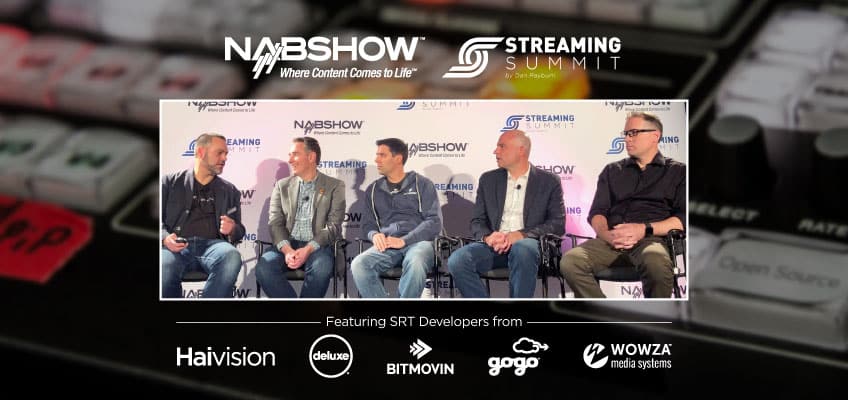In the third and final blog post of the SRT Trailblazers series from NAB Show 2019, we’re getting technical. During the Technical Panel at the Streaming Summit, Haivision, the original developer of SRT, offers a high level overview of the SRT roadmap including recent updates and a glimpse into what to expect for future releases. Panelists from Bitmovin, Deluxe, Gogo, and Wowza share their SRT implementation experiences and explain how the open source protocol is integral to their workflows.
What’s New and Exciting for the SRT Open Source Protocol?
Panel moderator and Vice President of Engineering at Haivision, Marc Cymontkowski, provides a recap on the latest SRT news and releases well as an update on the future roadmap. He highlights the recent addition of SRT to Open Broadcaster Software’s OBS Studio as well as improvements to the existing VLC integration. Marc details the most recent releases (SRT 1.3 and 1.3.2) which have included fully bi-directional transport, multiplexing on the UDP layer, encrypted fast file transfer and the ability to enforce encryption on a listener waiting for a call to come in. He also provides a preview of what to expect in the next two releases (SRT 1.4 and 1.5): a plugin API to extend the functionality of the protocol, a FEC plugin for those looking to compare ARQ and FEC as well as sockets groups which will allow multiple SRT sockets to be grouped and organized together for redundancy purposes or link bonding for example. Keep an eye on this blog for more updates!
Coming Soon to the SRT Open Source Code Base: SRT P2P
Marc was also excited to announce that Haivision will open source a low latency peer-to-peer video delivery protocol as part of the SRT framework. SRT Peer-to-Peer (SRT P2P) is a lightweight plugin-free decentralized peer-to-peer streaming technology that replicates low latency video streams securely between clients, enabling broad scale video delivery. You can read more about SRT P2P here.
As for the rest of the panelists, here’s what they had to say about the benefits of integrating SRT into their solutions:
SRT is an Important Piece of Wowza’s Solution
Co-founder of the SRT Alliance, Wowza, shares 3 different use cases where SRT is currently integrated. Charlie Good, Wowza’s CTO, gives a high level overview of where SRT is used in its workflows – for its brand new GoCoder SDK, its Wowza Streaming Engine and he explains how Wowza Streaming Cloud ties in with the newly released SRTHub for media routing in the cloud.
“SRT is an amazing solution for us and our customers who build on top of our products and solutions.”
Charlie Good, CTO, Wowza
SRT as a Live Contribution Protocol
Bitmovin’s Martin Smole describes the company’s encoding architecture and takes a deep dive into how SRT plays an important role as an additional contribution protocol. He explains how SRT shines as an ingest protocol compared to RTMP which, although commonly used for live streaming in the cloud, has many shortcomings; it’s not very reliable, it only supports one audio stream and doesn’t support the delivery of subtitles, unlike SRT. Martin also shares that SRT was really easy and fast to integrate into their product with little development effort required.
“SRT provides a lot of positives compared to RTMP”
Martin Smole, Director of Encoding, Bitmovin
Enabling TV in the Cloud (Literally)
Ty Bekiares, Director of Engineering at Gogo and the lead architect for Gogo TV, a live linear airborne TV service, explains how SRT has been instrumental in their live TV architecture using a centralized headend model based in the US. SRT has enabled Gogo to reliably transport content feeds from their broadcast partners to their datacenter and back out to their teleports for uplink. After exploring a number of expensive proprietary and commercial alternatives, Ty remarks that somewhat miraculously SRT was open sourced at the right time and was quickly integrated into their existing systems with great success.
“It’s been incredibly reliable and a side benefit of SRT is that it gives us a lot of metrics on our links.”
Ty Bekiares, Director of Engineering, Gogo
SRT Shines for Deluxe’s Distribution and Playout Solutions
Konstantin Wilms SVP Cloud & Media Architecture expands on how Deluxe is addressing the challenges of moving live video streams and VOD assets across its global broadcast delivery network using the latest cloud and IP technologies. This includes leveraging cloud-based microservices and SRT for moving streams securely and at low latency to and from its 78 global ingress and egress endpoints. Konstantin highlights the fact that Haivision Makito encoders are used as hardware appliances for SDI capture to IP playout and explains how SRT plays an important role in Deluxe’s Media Cloud distribution and playout solutions as it can be containerized for linking multiple cloud platforms and data centers.

